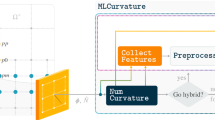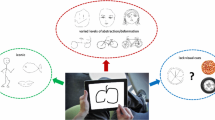Abstract
Neural networks can be used to classify images such as handwritten characters. A common method of doing this involves mapping the pixel values of the image onto the input nodes of a feed-forward net. This is problematic in that the topological properties of the original image space, such as the spatial relations between different pixels, are not immediately apparent to the net. We address this problem by using the real valued coordinates of selected features in the image for input to the net.
This paper details a formative study of the Curvature Primal Sketch (CPS) as a preprocessing method to identify the interesting features of the curves that make up handwritten characters. Emphasis is placed upon integrating the CPS with a feedforward neural network classifier. To this end, we describe an algorithm for selecting which of the features produced by the CPS should be used as input to the neural network. We postulate that the order in which the features are used as inputs to the net is also important and introduce a solution to this problem.
The nets obtained by this approach were small and performed recognition well. A net with dimensions 14–14–10 was trained with collection of 500 handwritten digits, collected from different people. On a similar test set of 100 digits, the net was found to achieve 92.8% accuracy in recognition.
Access this chapter
Tax calculation will be finalised at checkout
Purchases are for personal use only
Preview
Unable to display preview. Download preview PDF.
Similar content being viewed by others
References
Asada, H. and Brady, M.: The Curvature Primal Sketch. AI Lab Memo 758, Massachusetts Institute of Technology, 1984.
Fairbank, M.: A Neural Network Vision System based on the Curvature Primal Sketch. MSc thesis, Department of Artificial Intelligence, University of Edinburgh, 1995.
Le Cun, Y., Boser, B., Denker, J. S., Henderson, D., Howard, R. E., Hubbard, W., and Jackel, L. D.: Handwritten digit recognition with a back-propagation network. In Advances in Neural Information Processing Systems, volume 2. San Mateo: Morgan Kaufmann, 1990.
Denker, J. S., Gardner, W. R., and Graf, H. P.: Neural network recogniser for handwritten zip-code digits. In Advances in Neural Information Processing Systems, volume 1, AT&T Bell Labs, 1988.
Martin, G. L. and Pittman, J. A.: Recognising handprinted letters and digits. In Advances in Neural Information Processing Systems, volume 2. San Mateo: Morgan Kaufmann, 1990.
Tveter, D. R.: The ‘rbp’ back-propagation simulation program. 5228 N. Nashville Ave, Chicago, Illinois 60656.
Author information
Authors and Affiliations
Rights and permissions
Copyright information
© 1999 Springer-Verlag Wien
About this paper
Cite this paper
Fairbank, M., Tuson, A. (1999). A Curvature Primal Sketch Neural Network Recognition System. In: Artificial Neural Nets and Genetic Algorithms. Springer, Vienna. https://doi.org/10.1007/978-3-7091-6384-9_9
Download citation
DOI: https://doi.org/10.1007/978-3-7091-6384-9_9
Publisher Name: Springer, Vienna
Print ISBN: 978-3-211-83364-3
Online ISBN: 978-3-7091-6384-9
eBook Packages: Springer Book Archive




